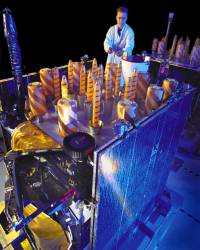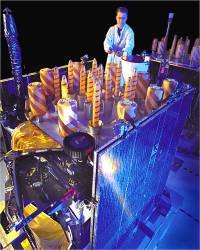 Block IIR-M satellite. Lockheed Martin photo.
Block IIR-M satellite. Lockheed Martin photo.Signal anomalies characterized by the U.S. Air Force as “out of family” transmissions will keep the latest GPS satellite from being declared healthy for months, if ever.
The report on space vehicle number (SVN) 49 by the GPS Wing’s chief engineer, Lt. Col. David Goldstein to the European Navigation Conference in Naples, Italy, on May 4 mixed bad news with glad.
Also known as Block IIR-20(M), the spacecraft carries the demonstration payload for the new civil GPS L5 signal. The March 24 launch probably represented the last chance to meet an International Telecommunications Union (ITU) deadline for securing primary rights to use of the RF band by GPS.
Signal anomalies characterized by the U.S. Air Force as “out of family” transmissions will keep the latest GPS satellite from being declared healthy for months, if ever.
The report on space vehicle number (SVN) 49 by the GPS Wing’s chief engineer, Lt. Col. David Goldstein to the European Navigation Conference in Naples, Italy, on May 4 mixed bad news with glad.
Also known as Block IIR-20(M), the spacecraft carries the demonstration payload for the new civil GPS L5 signal. The March 24 launch probably represented the last chance to meet an International Telecommunications Union (ITU) deadline for securing primary rights to use of the RF band by GPS.
A healthy L5 signal began transmitting on April 10. However, other GPS signals being broadcast by the satellite — particularly those at the L1 frequency — are demonstrating larger than expect pseudorange errors that appear to be elevation-dependent, Goldstein said. That is, they vary with the varying elevation angle of the satellite as it rises and sets in the sky.
The Air Force detected the anomalies on April 9, the day before the L5 broadcasts began. That suggests the out-of-family problem may stem from a fundamental mechanical difficulty, which can’t be fixed now that the spacecraft is in orbit, not a transient problem with the electrical system that could be remedied by system operators.
Because 18 other Block IIR satellites built by Lockheed Martin are on orbit and performing well, a substantial likelihood also exists that something about the L5 payload creating the problem.
The GPS Wing has a team “sorting out the problem,” Goldstein said, and predicted that several more months would pass “before we finish all of the trouble-shooting.”
The problem poses no immediate problem for GPS users. Thirty GPS satellites are currently in orbit and broadcasting healthy signals; however, the full operational constellation for GPS only requires 24 satellites.
“We’re in no hurry because of our overpopulated constellation,” Goldstein told the ENC audience. SVN49 officially remains in the early orbit check-out phase. However, the Air Force “harvested” the pseudorandom noise (PRN) code number (PRN01) of a GPS satellite alread in orbit to use on SVN49. That reduced the constellation by one.
However, the uncertainty created by the signal anomalies will probably delay launches of the last modernized Block IIR satellite, currently scheduled for August, and the first next-generation Block IIF, which had been expected to be launched late this year or early in 2010.
The demonstration L5 transmissions vary in a number of ways from the operational L5 signal specification. In its forthcoming May/June issue, Inside GNSS will carry two articles on initial observations of the L5 and other SVN49 signals by researchers at Stanford University and Ohio University.
Under any foreseeable circumstances, SVN49 will not broadcast L5 forever, Goldstein said. Once the Block IIF satellites — on which the signal is standard — are launched, the demonstration payload will be switched off.




